The bottom line: One in three families can’t afford diapers. Why are they so expensive?
This story was written with the support of the National Health Journalism Fellowship, a program of the University of Southern California’s Annenberg School of Journalism.
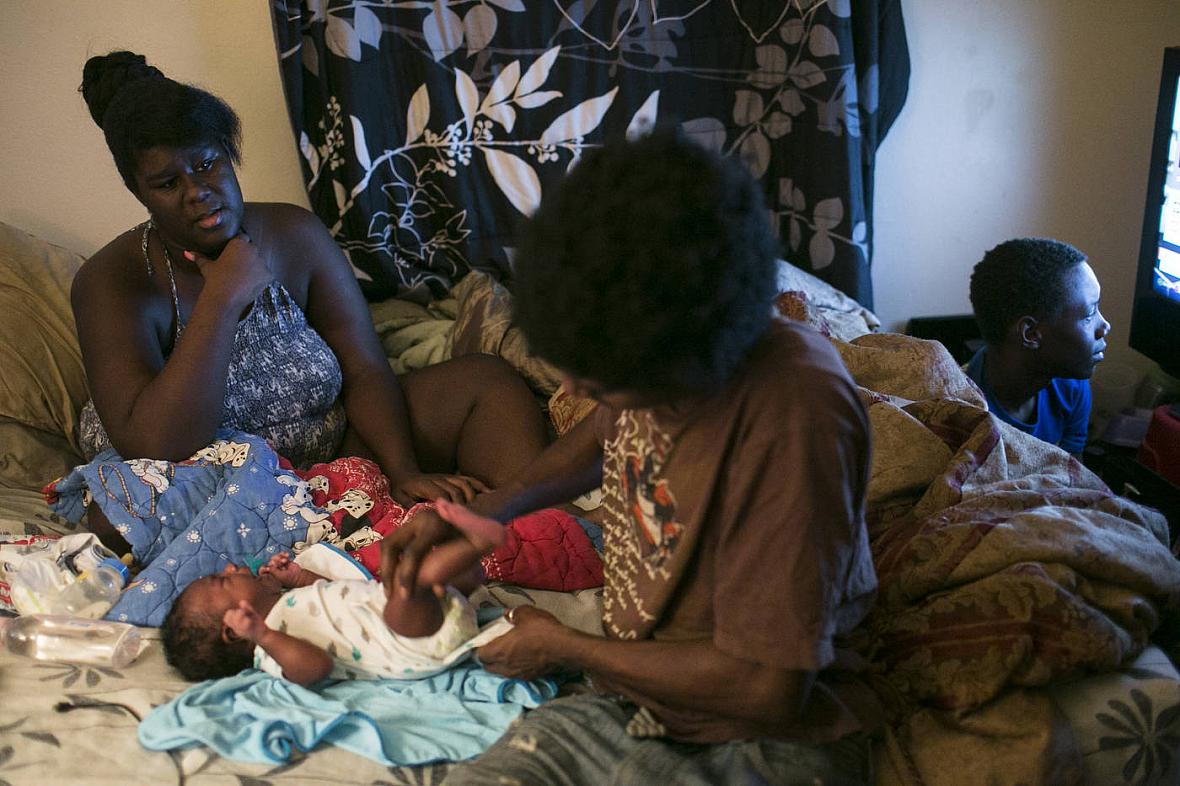
Lalandria watches as her boyfriend, John, dresses Amound. (Photos by Eve Edelheit / The Tampa Bay Times)
One afternoon in November, 500 scientists, engineers and executives gathered at a luxury hotel in Austin to imagine the future of baby diapers.
Some had come from as far away as Sri Lanka and Australia. They demonstrated their latest innovations, got misty-eyed watching videos about diapers for preemies, and toasted the year’s accomplishments with wine and cocktails.
The conversations were friendly, but everyone in the room knew the stakes. The next generation of diapers was coming. Whoever developed it stood to control a market worth $9 billion in North America alone.
Today’s diapers are small miracles of industrial science, the experts say. They are softer, thinner and longer lasting than ever before, not by accident, but because companies like Procter & Gamble and Kimberly-Clark have poured billions of dollars into research and development. Like tech companies, they’ve put a premium on transformative ideas.
But the advances have come at a cost. Diapering a child now takes about $1,000 a year for an average product. For families on the cusp of poverty, it’s a serious burden, and a dwindling supply can have lasting consequences on both children and parents.
Safety net programs are little help. Only one form of public assistance can be spent on diapers, and in Florida the average benefit hasn’t increased in more than two decades.
Across America, millions of parents find themselves caught amid these opposing forces: diapers that keep getting better but not cheaper, the gap in assistance for the poor and the every-few-hours wail of a child who needs a change.
Lalandria Goolsby discovered the diaper divide nine months into her pregnancy. It didn’t take long to realize what it meant for her family in St. Petersburg. Affording diapers was going to be difficult.
What would happen, she wondered, if she ran out?
The first sign Lalandria was pregnant came one morning during her shift at a commercial cleaning company. The smell of the chemicals made her feel sick. She ducked into a bathroom and threw up.
A doctor later confirmed what her boyfriend, John Keels, suspected. Lalandria started to cry. She wasn’t ready to have a baby. She was 21, still living at home with her mother and siblings.
Yet an abortion was out of the question. As a teenager, Lalandria had been diagnosed with endometriosis, a painful condition that affects a woman’s reproductive system, and warned she might never conceive. This could be her only chance.
She waited three months to tell her mother. Jennifer Goolsby could be stern with her kids. But this time, she didn’t raise her voice or lecture. “It happened for a reason,” she told her daughter. “Now, we have to work together to make sure this baby is happy and well taken care of.”
Lalandria was 21 when she found out she was pregnant. The pregnancy felt like a blessing, but Lalandria worried about the expenses.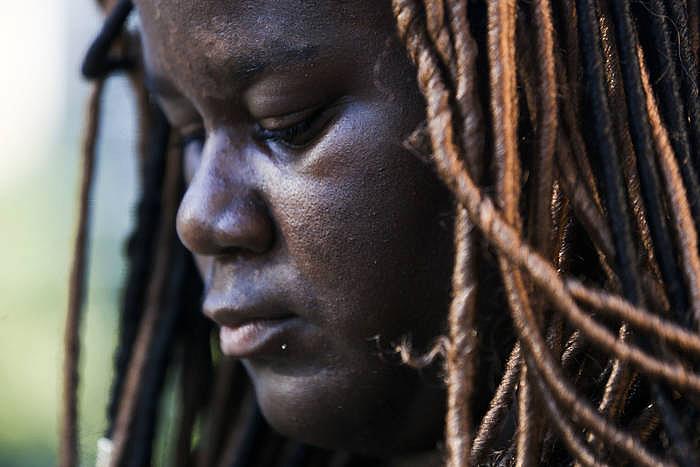
The pregnancy was difficult. Lalandria had extreme morning sickness. Her doctors worried she would miscarry. She left her job to avoid harsh chemicals and being on her feet all day. She wasn’t used to staying home; she had worked since high school. She spent much of her time scrolling through parenting blogs.
Lalandria made a mental list of the things she needed: playpen, bathtub, stroller, car seat. Finally, a month before her due date, she was approved for cash assistance. She made plans to go shopping right away.
Her whole family went with her. They rode together in the car they shared. When they arrived at the Kmart, Lalandria led them right to the diaper aisle.
A shrink-wrapped package with a high-resolution photo of a sleeping newborn was the first to catch her eye. She pulled it down from the shelf: $10 for 32 diapers.
“Wow,” she muttered.
She found a box that cost a little more, but contained far more diapers. She loaded six into her cart. Then she stopped to do the math. Lalandria had $180 in cash assistance that month to pay for everything that wasn’t food. Diapers would eat up more than half.
Throughout her pregnancy, Lalandria had fantasized about raising her child far from the St. Petersburg housing project she called home, somewhere full of opportunity, maybe California. Now she was starting to worry. How could she do any of that if she couldn’t even afford diapers?
In the United States, the average diaper sells for about 25 cents.
The quarters add up quickly. Newborns need as many as 12 changes a day. That’s $21 per week, or $84 per month. Bigger kids need fewer, but their diapers are more expensive.
For a single mom or dad working full time at minimum wage, the cost can consume 6 percent of total annual pay. For the lowest-income parents, it’s as much as 14 percent.
New research shows a third of families in the United States struggle with the expense.
Cloth diapers aren’t always an option. They are difficult to clean without a washing machine at home or paying for a service. Some coin laundries don’t allow them in their machines.
Also, most daycares require parents to bring a supply of disposable diapers each morning. Without daycare, or a sitter, a single parent can’t work or go to school.
Not all diapers are created equal.
No-frills models can cost 15 cents or less, but don’t last long.
“You will probably find yourself going through them twice as frequently,” said Pricie Hanna, a Pennsylvania-based consultant who has studied the industry for more than three decades.
Mid-range diapers usually cost 20 to 30 cents and last longer. Premium diapers with eco-friendly features can cost 50 cents or more.
Parents can save by buying in bulk at a wholesale club or online. Amazon offers even deeper discounts to members of its $12.99-a-month Prime service who sign up for regular shipments.
“The most expensive way to buy (diapers) is one package at a time at a local drug store,” Hanna said. “Unfortunately, some people who are tight on their budgets have to do that.”
Lalandria’s baby arrived last April 1.
He was in distress during delivery, so doctors ordered an emergency Caesarean section. Lalandria held her son for the first time in the recovery room. He was smaller than she expected. His skin was pale, almost translucent.
She named him Amound because she liked the way it sounded: unique, like her own name.
Lalandria and Amound left the hospital three days later. Home was her mother’s three-bedroom townhouse in the aging Jordan Park housing project, where residents frequently complained of mold and pests.
Lalandria was too tired to climb the stairs to the room she shared with her 19-year-old sister Tatiana. Instead, she placed the baby in his playpen and settled into the couch. She dozed off as her brother played video games and the two foster children in her mother’s care conspired in the corner.
Amound’s cries jolted her awake. He needed to be changed.
Lalandria couldn’t go back to work immediately; the doctors put her on bed rest until she recovered from the C-section. John moved in and promised to help financially. But he couldn’t find a job.
Lalandria gives Amound a bath.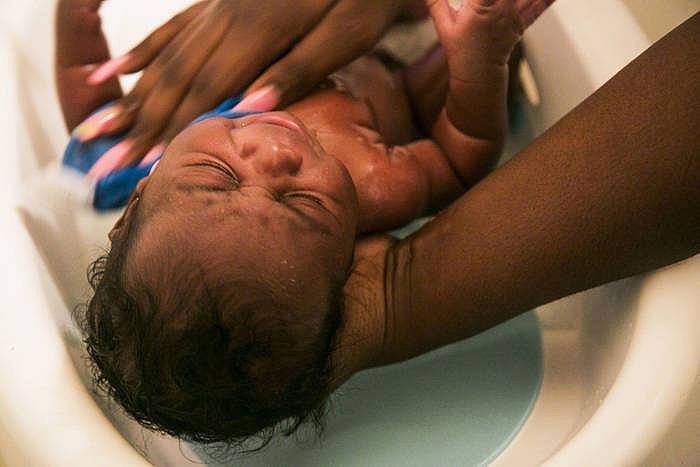
It look less than three weeks for Lalandria to run out of diapers. (More than half of the ones she bought at Kmart were too big.) It happened when Lalandria was riding in the car with her mother. Tatiana was in the back, cooing at the baby.
Tati sniffed his diaper and wrinkled her nose. She rifled through the old backpack Lalandria was using as a diaper bag.
“There's nothing in here,” she said.
“You check the front pocket?” Lalandria asked.
“Nothing.”
Lalandria had just $18 left in cash assistance for the month. She promptly drained it on two small packs of store-brand diapers from Publix.
Within days, Lalandria was back down to just five clean diapers. The moment she realized, she felt her chest tighten. She began pacing her room.
An hour later, she called her uncle and asked for help.
He stopped by early the next morning with two small packs. Lalandria thanked him. But the tightness in her chest remained. She knew how quickly those diapers would go.
Amound holds onto his father’s finger.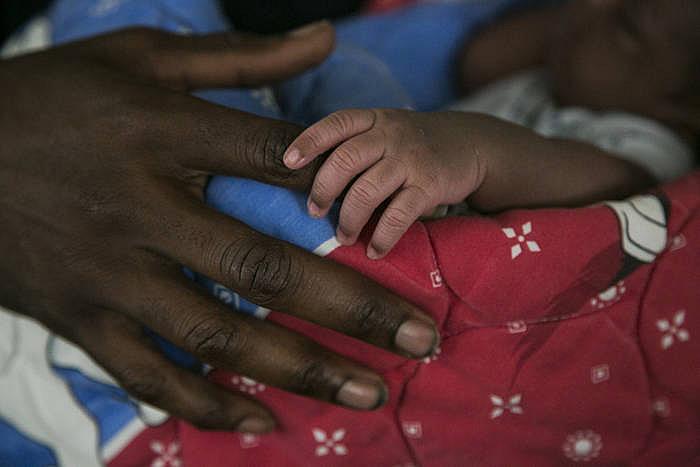
Industry insiders have a different perspective on diaper prices.
“Given the technology that’s inside them,” consultant Heidi Beatty said, “they are super cheap.”
Beatty spent a decade developing products for Johnson & Johnson. She considers diapers among the most sophisticated personal care items available today.
Scientists create SAP by linking molecules of acrylic acid into chains. The chains form a three-dimensional web that traps liquid and holds it in place.
The more SAP, the less likely a diaper is to leak.
Superabsorbent polymers made by the international chemical company BASF can absorb 300 to 500 times their weight in water, BASF technical specialist James Robinson said. They can absorb 50 to 70 times their weight in urine, which is more salty.
Modern diapers also have a “breathable” backsheet that lets vapor but not liquid through. Flexible closures ensure a tight fit. Ultra-soft elastic waist and leg bands keep poop from seeping out.
The technology helps keep babies healthy, according to the manufacturers. So does changing diapers often. Delays can lead to painful diaper rashes and infections. Frequently running low can affect a parent’s mental health, studies show.
A single dad in Chicago — an ex-convict trying to turn his life around for his young daughter — told news website ProPublica Illinois that the only diapers he could afford came from the dollar store. They gave his baby hives.
He grew desperate, and started working as a black-market gun broker.
Lalandria changes Amound's diaper while her family gets ready for the day.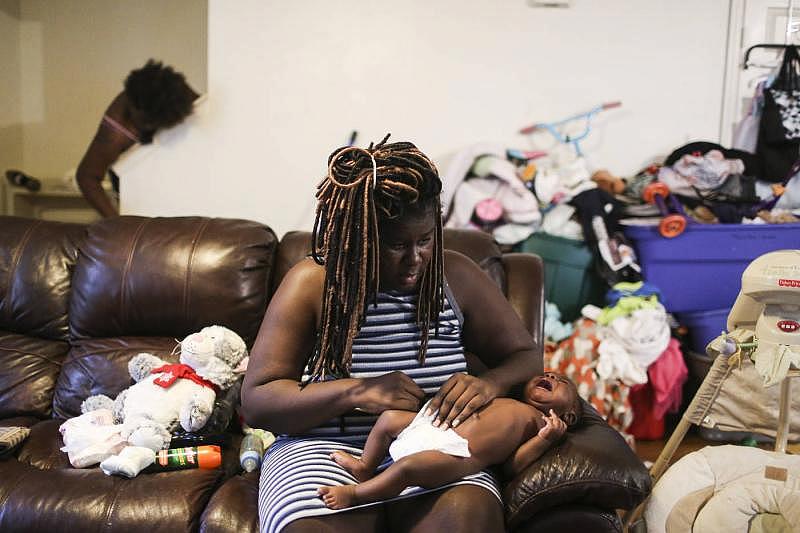
There was no question in Lalandria’s mind which diapers were best. She believed Huggies were the softest and most comfortable. The least likely to leak, too.
Her feelings were no accident. Diaper companies spend billions on advertising and marketing. Procter & Gamble, which makes Pampers and Luvs, among other personal care and cleaning products, spent more than $7 billion on advertising in 2017 alone, according to its latest annual report — more than the GDP of any of the poorest 50 countries.
Diaper companies also create their own web content, engage millennial moms on Pinterest and Instagram, and send freebies to “influencers” with thousands of social media followers.
Each company has its own strategy. Kimberly-Clark, the maker of Huggies, markets “the emotion of motherhood” rather than the effectiveness of its diapers, said Maria Bailey, the Florida-based author of Millennial Moms.
“A lot of their advertising focuses on the fact that we know you’ve been up all night, we know that you are tired,” Bailey said.
The brand is also cashing in on successful campaigns from the 1980s and ’90s, Bailey said. That’s because millennial women look to their mothers for product recommendations.
Jennifer was a Huggies mom. Lalandria wanted to be, too.
There was usually no money for that.
Budget diapers are less expensive than premium brands, but often don’t last as long.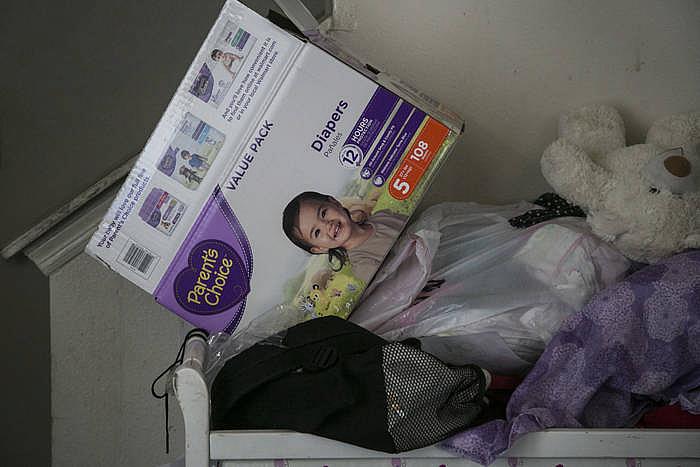
Jennifer bought diapers and wipes whenever she could. She was working at Publix and could pick them up after a shift. Still, Lalandria never had enough.
“God will make a way,” she told herself.
Lalandria gradually adjusted her routine. Instead of reaching for a new diaper whenever the indicator strip changed color, she waited until the diaper started to sag.
One evening, just before Amound’s one-month checkup in May, Lalandria's grandmother noticed red splotches on his bottom.
“Diaper rash,” she said.
Lalandria dabbed cream on it until it disappeared.
The pressure had John and Lalandria fighting. He started spending less time at the townhouse. Lalandria was off bedrest now, but kept to her bedroom, the curtains drawn, the baby beside her.
At a checkup, a doctor asked Lalandria if she was stressed or anxious.
“Both,” Lalandria replied.
The diagnosis was postpartum depression.
Disposable diapers weren’t widely available until 1961, when Procter & Gamble introduced Pampers. More than a decade later, the company had its first serious competitor: Kimberly-Clark’s Huggies.
Things got ugly. In 1986, Procter & Gamble sued Kimberly-Clark, claiming the company was illegally using its patented elastic-waistband technology. Kimberly-Clark said the idea was obvious, and moved to have the patent invalidated.
Kimberly-Clark won the battle. But the nation’s top two diaper companies continued to duke it out in court for years. The fight was so bitter, insiders called it the “diaper wars.”
Today, Kimberly-Clark and Procter & Gamble compete alongside some two dozen generic brands sold at grocery stores, toy stores and supercenters.
The newest players are startups targeting high-income parents. Many market themselves as natural alternatives. The Honest Company, founded by actor Jessica Alba, uses sustainably harvested pulp in its diapers. Parasol’s are hypoallergenic, chlorine-free, fragrance-free, lotion-free, latex-free, and free of lead and heavy metals. Poof says its diapers are fully biodegradable and couture inspired.
Companies large and small keep their designs and production processes secret. Visitors aren’t allowed in factories.
Jacob Shivers, 8, with his mother, Melissa Ann Shivers, at their home in Northeast Philadelphia. Jacob tried to wake up his classmate Lucas Sims after he became "unresponsive" during story time at Loesche Elementary.
The Tampa Bay Times reached out to five companies, hoping to talk about the business of baby diapers. Kimberly-Clark and Honest offered to discuss charitable giving, but not design, engineering or manufacturing. Procter & Gamble was one of three companies that didn’t return calls or emails.
The top manufacturers don’t publicly report profit margins on their diapers, and many insiders won’t discuss the bottom line. Consultant Carlos Richer, who ran a large diaper factory in Mexico, joked he would become “the enemy of the diaper industry” if he did.
Carl Cucuzza, a consultant based in Georgia, said Huggies and Pampers typically make about 2 cents per diaper. The profit on a generic diaper, he said, is about half that.
It’s “good money,” he added. Billions of diapers are sold annually.
Business will likely get better.
At the conference in Austin, industry leaders discussed ways to make their diapers fancier. More environmentally friendly. And thinner — both for the baby’s comfort and to fit more packages on grocery store shelves.
There were no panels on bringing down the price, or diaper affordability.
At the conference, Huggies shows off its latest product: diapers for “micro-preemies” weighing two pounds or less.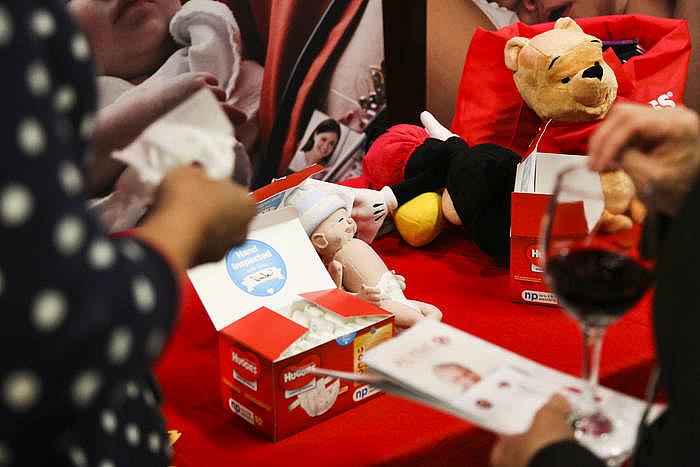
Richer said later that some Latin American companies sell reliable diapers for 10 cents. But companies in the United States, he said, “have not been interested in selling to that particular population.”
“In order to make more money, you have to make a more sophisticated product,” he said.
Asked why affordability was not on the schedule, Dave Rousse, the president of the nonwoven fabrics industry association, which organized the conference, said it was up to diaper companies to determine “the level of support they are going to give to that sector.”
Rousse said there are value-priced diapers on the U.S. market, and pointed out that manufacturers like Kimberly-Clark and Procter & Gamble donate millions of diapers each year. The Huggies brand commissioned a study on diaper need and is a founding sponsor of the National Diaper Bank Network.
But, Rousse said, “a disposable product for a family that has financial burdens is sometimes a stretch. Sometimes, they need to reconsider how they meet their needs.”
Later in May, for the first time since the baby arrived, it looked like Lalandria’s life might get easier. John had been hired part time at a Family Dollar. Not only would he have a paycheck, he could buy discount diapers and wipes.
The relief was short lived. In June, their case manager delivered bad news. John’s $10-an-hour job meant they no longer qualified for cash assistance.
Suddenly there was far less money for diapers.
Most families living below the poverty line rely on a patchwork of government assistance programs: Medicaid for health insurance; food stamps; and a program that provides healthy food to women, infants and children, known as WIC.
Cash assistance is the only one that can go toward diapers, wipes and other essential baby supplies that aren’t food.
Florida’s cash assistance program requires recipients to be employed or looking for work. But a family of three also can’t make more than $303, the maximum monthly benefit.
For Lalandria, John’s new job meant the family made too much.
Lalandria had already been looking for work, but that week, she stepped up her efforts. She applied for call-center jobs, cleaning jobs, fast-food jobs. Nothing worked out.
Lalandria waits for the bus to take her to a job interview in June.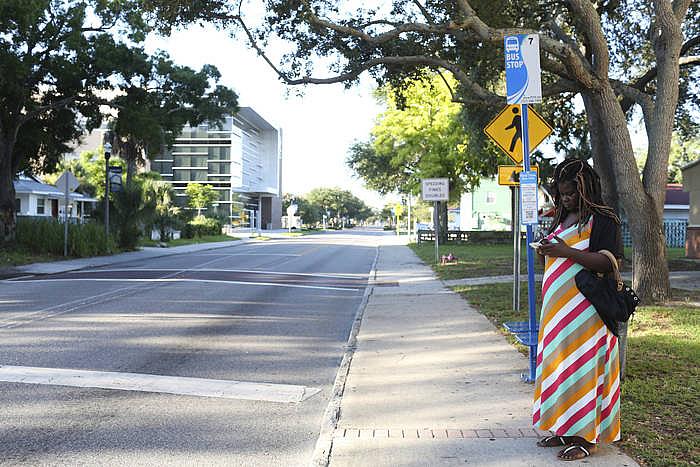
The heat and humidity was making everyone cranky, including Amound. One afternoon, he started wailing for no obvious reason. She rocked him, offered him his pacifier. He cried louder.
Lalandria didn’t know what to do. It wasn’t just the screaming baby, or the lack of sleep, or the fact John had hardly been around. Every day, she was running out of something Amound needed.
She started the familiar retreat to her bedroom, where she could draw the curtains and hide. But halfway up the stairs, with the baby in her arms, she sat down and cried.
Experts call diaper need a “silent crisis.”
“People don’t talk about having enough diapers,” said Alison Weir, who oversees policy and research at the National Diaper Bank Network. “It’s embarrassing. But it is such a basic need. If you aren’t actively changing diapers, you don’t think about it.”
In March 2016, it caught the attention of the White House.
In a blog post, an advisor to then-President Barack Obama pointed out that families can be forced to choose between buying diapers and paying for food, rent or utilities.
“That’s a choice that no family should have to make,” she wrote.
Obama urged Congress to devote $10 million to the problem. Congress did nothing.
Some states have taken action. In California, Democratic Gov. Jerry Brown recently approved $30 in monthly diaper benefits for families in the state’s cash welfare-to-work program.
In Florida, the number of families receiving cash assistance has dropped from 214,000 to 48,000 since 1995, even as the number of poor families has increased, according to the Center on Budget and Policy Priorities. The benefit for a family of three has stayed the same.
Florida lawmakers have considered eliminating the sales tax on baby diapers for the last two years. The savings would amount to about $50 annually for the average family, according to Sen. Lauren Book, a Democrat from Plantation who sponsored both bills.
This year and last, the idea won support early in the legislative session. Both years, it stalled out.
Several nonprofits are trying to fill the gap. The Tampa Bay region has at least two diaper banks: Babycycle in St. Petersburg and the Here We Grow Foundation in Clearwater.
Babycycle distributes about 250,000 diapers and wipes to social service providers annually. But some agencies get fewer than they request, and others are on a waiting list.
Here We Grow gives directly to about 250 families each year. Program director Meredith Scott, a mother who once ran out of diapers herself, said she doesn’t have enough to keep up with the need.
Lalandria’s mother found her on the stairs that day, crying.
Jennifer Goolsby set down her purse.
“You need to find the strength to help him,” Jennifer said. “You have to fight.”
Late that afternoon, while Amound napped, Jennifer and Lalandria devised a strategy to clip coupons and find the best deals on diapers. They came up with a long-term plan, too. Lalandria would keep applying for jobs. When she found work, Jennifer would change her own work schedule so she could watch the baby. And when Lalandria saved up enough money, she would find a place of her own.
Weeks later, Lalandria walked into restaurant in the final phases of construction in Pinellas Park. She walked out with a job.
At one of her first shifts, she stood behind the counter and greeted everyone who came through the doors.
“Welcome to Culver’s!”
Lalandria rings up an order as a cashier at Culver’s in Pinellas Park.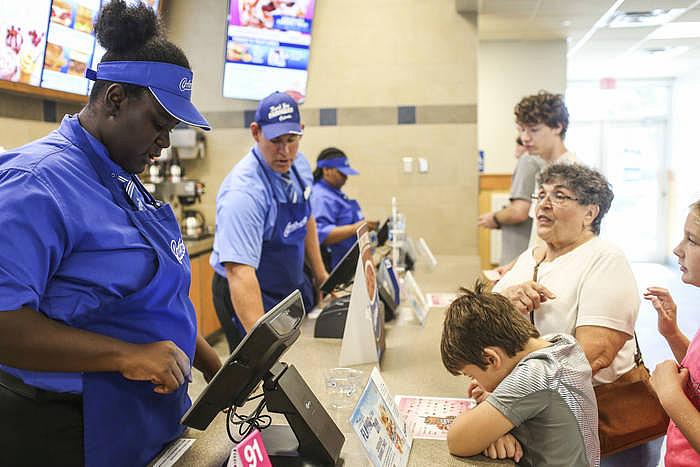
Days into the job, Lalandria felt different. She knew that $8.25 an hour wouldn’t go far. She planned to give most of it to her mom, anyway. But she looked forward to helping with the bills again. She might even have a few dollars for new clothes, or a night out with friends.
Things felt different at home, too. Amound hadn’t stopped crying; a tooth poked through his pink gums. But he was sleeping through the night. And he smiled and cooed more.
Lalandria still thought about California. She wanted to get a better job first. Maybe she would get certified as a home health aide or a nursing assistant, or go back to school.
For now, she was content with small victories.
A few days later, Lalandria found herself in the diaper aisle at her neighborhood grocery store. She knew just what she wanted. She wiggled a pack from the shelf, paid cash, and left.
Tonight, she was bringing home Huggies.
[This story was originally published by The Tampa Bay Times.]
[Photos by Eve Edelheit / The Tampa Bay Times.]

